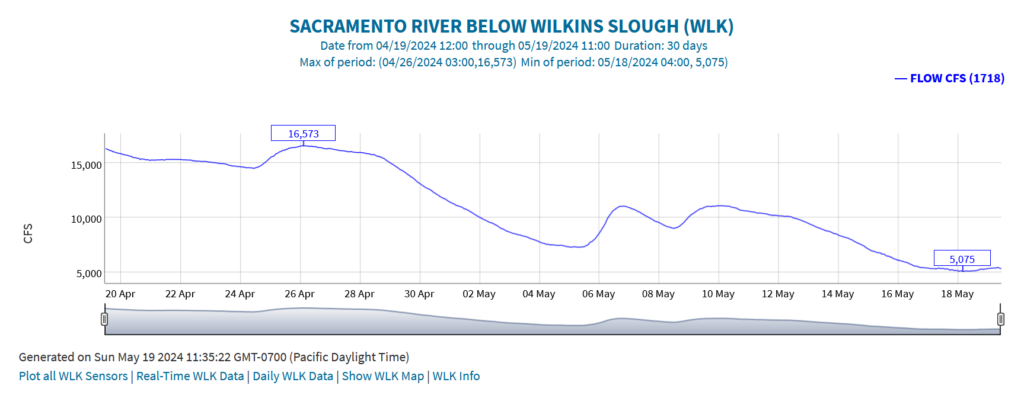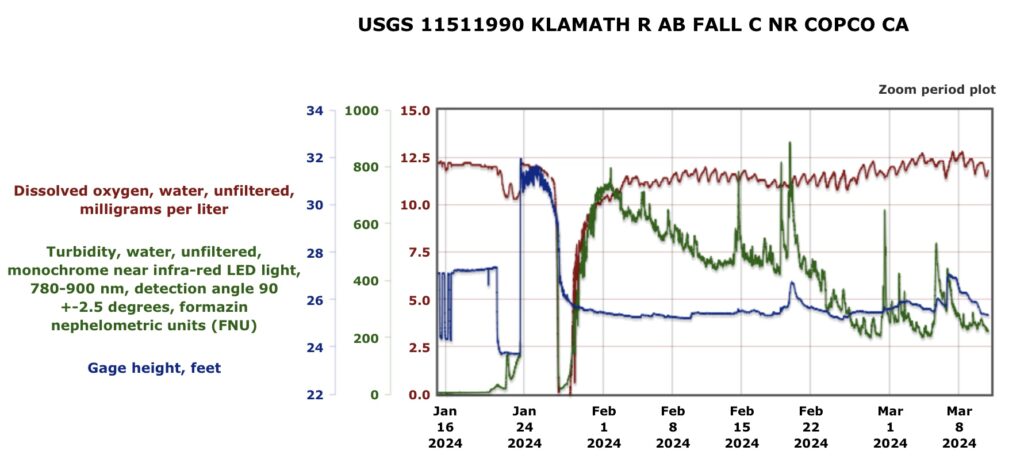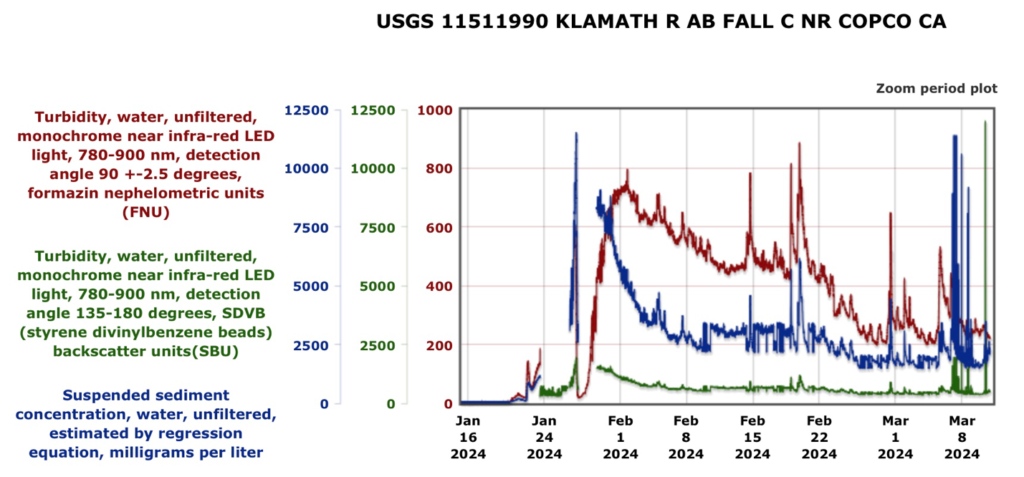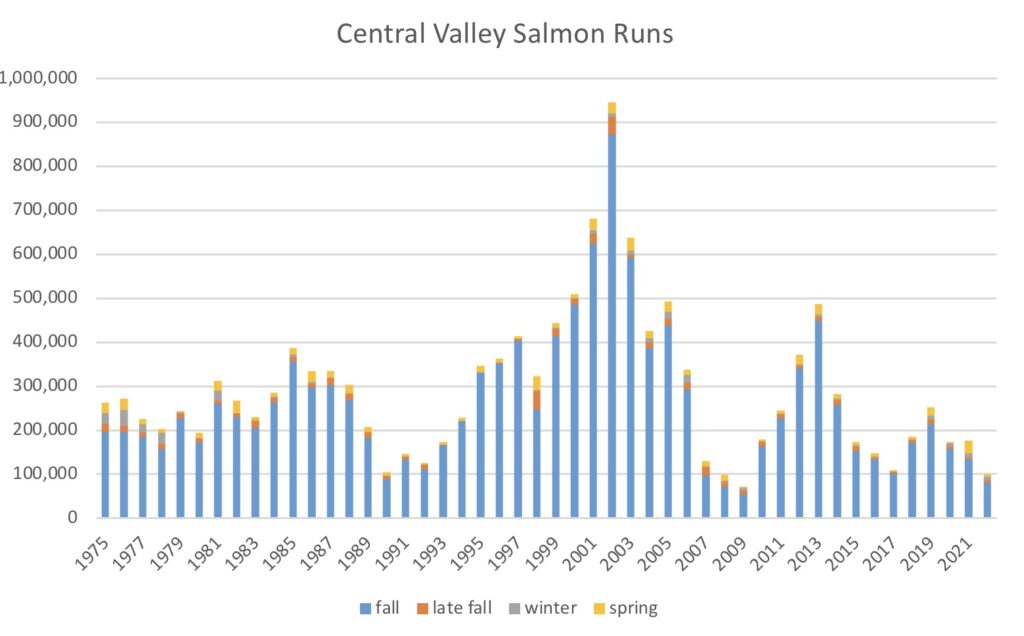The US Bureau of Reclamation (Reclamation), in cooperation with other state and federal agencies, conducted two short-term flow release experiments from Shasta Reservoir in the spring of 2024 to help juvenile salmon reach the ocean. 2024 is a relatively wet year, and it follows a very wet year in 2023 that left a lot of water in storage in Shasta and other Reclamation reservoirs.
The peak emigration to the ocean of wild and hatchery spring-run and fall-run salmon smolts usually occurs in the April-May time period, but may extend into June, especially in wetter years. Reclamation and its partners are developing pulse flow prescriptions for a flow management plan as part of the Action for the Long Term Operation of the Central Valley Project and State Water Project. “Spring pulse flows are designed to improve survival rates of outmigrating spring-run Chinook salmon smolts through the Sacramento River.” 1
The major sources of spring-run salmon smolts include Clear, Battle, Deer, Mill, and Butte creeks, and the Feather River Fish Hatchery. These smolts must pass through the lower Sacramento River, Delta, and Bay. The Feather River Fish Hatchery released its smolts into the lower Feather River in mid-March.
Pulse flows from Shasta Dam pass through Keswick Reservoir, a small regulating reservoir immediately downstream of Shasta Reservoir, and then into the Sacramento River. Pulse flows from Keswick Dam at river mile 300 of the Sacramento River also help move juvenile fall-run salmon downstream. Most Sacramento River fall-run salmon spawn and rear in the 20 miles of the river immediately downstream of Keswick Dam. Pulse flows help move juveniles from this reach downstream to reaches where the flow from tributary rivers and streams augments the flow in the mainstem Sacramento.
The goal of the pulse flows was to release extra flow (3000-6000 cfs) from Shasta reservoir to maintain 11,250 cfs below Keswick Dam for several days (see first pulse in Figure 1). With tributary inflow, river flow near Red Bluff 50 miles downstream was about 15,000 cfs during the first pulse. By the time the first pulse reached Wilkins Slough, nearly 200 miles downstream, the overall flow reached 16,000 cfs (Figure 2), after 3000-5000 cfs of agricultural diversions and multiple tributary inflows. At the end of the pulse flow period, Keswick Dam releases were dropped 6000 cfs (see Figure 1). By May 5, Sacramento River flow at Wilkins Slough had dropped about 8000 cfs. Declining tributary inflows and increased diversions also contributed to the lower Wilkins Slough flows following the pulse flow.
Without adequate flow, juvenile salmon have poor survival during their downstream journey. Low flows increase juvenile salmon’s vulnerability to predation. Low flows also contribute to stressful warm water temperatures. On May 1, 2024, water temperature in the river at Sacramento was below 65oF (18oC), with peak catch of juvenile salmon in the trawl survey (Figure 3). In contrast, in critically dry year 2022, May 1 water temperatures exceeded 65oF, with less than half the 2024 river flow (Figure 4). By late May 2022, water temperatures exceeded 70oF.
In conclusion, the releases of pulse flows from Shasta and Keswick reservoirs had very little signature in the lower Sacramento River due to intervening flows and diversions. The pulse flows were most beneficial in the upper river, where they made up a third to half the river flow. In a wet year like 2024, the benefit is somewhat limited by already high natural flows, although any additional pulse flows later this spring could be of greater benefit with expected declining natural flows and higher air temperatures. In contrast, pulse flows in dry years would provide much greater net potential benefit because of poor natural flows and limited reservoir storage.
The net benefits of pulse flows from Shasta Reservoir must also be considered, of course, in combination with Reclamation’s management of agricultural water deliveries and water stored in Shasta Reservoir for summer temperature management.

Figure 1. Streamflow in the upper Sacramento River below Keswick Dam (RM 300) April 19 through May 19, 2024. Note three-day flow pulses beginning April 23 and May 7.

Figure 2. Streamflow in the middle Sacramento River below Wilkins Slough (RM 120) April 19 through May 19, 2024. Note signatures of the three-day flow pulses show up on April 26 and May 10.

Figure 3. Juvenile salmon trawl catches and water conditions near Sacramento in winter-spring 2024. Note flow pulse in late April.

Figure 4. Juvenile salmon trawl catches and water conditions near Sacramento in winter-spring 2022. There were no flow pulses from Keswick Dam until irrigation releases commenced in May. Catch of juvenile salmon ceased once water temperatures reached or exceeded 70oF in late May.






